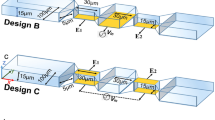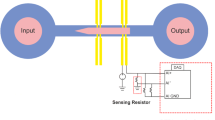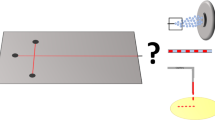Abstract
The impedimetric sensing techniques for single cell characterization have witnessed growing interest due to their high sensitivity and widespread applications. However, adapting the method to different biological measurements in microfluidic environments under various input conditions can result in feeble signal detection leading to a drastic decrease in the sensor sensitivity. The reduced signal-to-noise ratio (SNR) hinders the signal differentiation, sensor accuracy and prohibits fully integrated point-of-care applications. Here, we address the sensitivity enhancement for microfluidic impedimetric sensing of micron and submicron-sized microparticles by exploring novel circular shape electrodes in a simulation study. The influence of radial electrode parameters on differential electrical signal is systematically analyzed in COMSOL Multiphysics using spherical particles ranging from 0.75 µm to 5 µm in diameter. Detailed analysis revealed the strong impact of the circular shape microelectrode geometry and the electrode gap on the signal strength, resulting SNR, and device sensitivity for multiple bioparticles detection. Specifically, ˃ 50 dB improvement in SNR was enabled by optimizing the circular electrode geometrical parameters. Our proposed sensing modality can be adapted for nanoparticles detection by further optimizing the microfluidic device parameters.
Graphical abstract







Similar content being viewed by others
References
I. Bilican et al., Focusing-free impedimetric differentiation of red blood cells and leukemia cells: A system optimization. 307, 127531 (2020)
B. Brazey et al., Impedance-Based Real-Time Position Sensor for Lab-on-a-Chip Devices. 18(5), 818–831 (2018)
C.A. Chapman et al., Electrode fabrication and interface optimization for imaging of evoked peripheral nervous system activity with electrical impedance tomography (EIT). 16(1), 016001 (2018)
C.H. Clausen et al., Bacteria Detection and Differentiation Using Impedance Flow Cytometry. 18(10), 3496 (2018)
C.H. Clausen et al., Coplanar Electrode Layout Optimized for Increased Sensitivity for Electrical Impedance Spectroscopy. 6(1), 110–120 (2015)
J. Cottet et al., How to Improve the Sensitivity of Coplanar Electrodes and Micro Channel Design in Electrical Impedance Flow Cytometry: a Study. 23(1), 11 (2019)
W.H. Coulter, Means for counting particles suspended in a fluid. Google Patents. (1953)
N. Couniot et al., Signal-to-Noise Ratio Optimization for Detecting Bacteria with Interdigitated Microelectrodes. 189, 43–51 (2013)
A. Faenza et al., Impedance Measurement Technique for High-Sensitivity Cell Detection in Microstructures with Non-Uniform Conductivity Distribution. 12(11), 2046–2052 (2012)
R. Gomez-Sjoberg, D.T. Morisette, R. Bashir, Impedance microbiology-on-a-chip: Microfluidic bioprocessor for rapid detection of bacterial metabolism. 14(4), 829–838 (2005)
M.T. Guler et al., A simple approach for the fabrication of 3D microelectrodes for impedimetric sensing. 25(9), 095019 (2015)
N. Haandbæk et al., Characterization of Subcellular Morphology of Single Yeast Cells Using High Frequency Microfluidic Impedance Cytometer. 14(2), 369–377 (2014)
U. Hassan, R. Bashir, Electrical cell counting process characterization in a microfluidic impedance cytometer. 16(5), 697–704 (2014)
C. Honrado et al., A neural network approach for real-time particle/cell characterization in microfluidic impedance cytometry. 1–11 (2020)
S.M.A. Iqbal, N.Z. Butt, Design and analysis of microfluidic cell counter using spice simulation. 1(10), 1–10 (2019)
M. Javanmard et al., Electrical Detection of Protein Biomarkers Using Bioactivated Microfluidic Channels. 9(10), 1429–1434 (2009)
D. Juronen et al., Immunosensing System for Rapid Multiplex Detection of Mastitis-Causing Pathogens in Milk. 178, 949–954 (2018)
O. Laczka et al., Detection of Escherichia Coli and Salmonella Typhimurium Using Interdigitated Microelectrode Capacitive Immunosensors: the Importance of Transducer Geometry. 80(19), 7239–7247 (2008)
H. Matbaechi Ettehad et al., Towards CMOS Integrated Microfluidics Using Dielectrophoretic Immobilization. 9(2), 77 (2019)
B. Mead, Closed Loop Control of a Cylindrical Tube Type Ionic Polymer Metal Composite (IPMC). (2013)
J. Mok et al., Digital Microfluidic Assay for Protein Detection. 111(6), 2110–2115 (2014)
C. Pfeffer et al., Towards Easy-to-Use Bacteria Sensing: Modeling and Simulation of a New Environmental Impedimetric Biosensor in Fluids. 21(4), 1487 (2021)
S. Prakash et al., Design of a Multiplexed Analyte Biosensor Using Digital Barcoded Particles and Impedance Spectroscopy. 10(1), 1–10 (2020)
R. Reale et al., Electrical Measurement of Cross-Sectional Position of Particles Flowing through a Microchannel. 22(4), 1–13 (2018)
J. Riordon, M. Mirzaei, M. Godin, Microfluidic cell volume sensor with tunable sensitivity. 12(17), 3016–3019 (2012)
R. Rodriguez-Trujillo et al., High-Speed Particle Detection in a Micro-Coulter Counter with Two-Dimensional Adjustable Aperture. 24(2), 290–296 (2008)
R. Rodriguez-Trujillo et al., Label-Free Protein Detection Using a Microfluidic Coulter-Counter Device. 190, 922–927 (2014)
D. Ruffatto, J. Shah, M. Spenko, Optimization and experimental validation of electrostatic adhesive geometry. in 2013 IEEE Aerospace Conference. IEEE. (2013)
A. Sanchis et al., Dielectric Characterization of Bacterial Cells Using Dielectrophoresis. 28(5), 393–401 (2007)
M. Shaker et al., An Impedance-Based Flow Microcytometer for Single Cell Morphology Discrimination. 14(14), 2548–2555 (2014)
R. Wang et al., A label-free impedance immunosensor using screen-printed interdigitated electrodes and magnetic nanobeads for the detection of E. coli O157: H7. 5(4), 791–803 (2015)
J.-W. Wang et al., Effects of Electrode Geometry and Cell Location on Single-Cell Impedance Measurement. 25(6), 1271–1276 (2010)
M.H. Wang, L.S. Jang, A systematic investigation into the electrical properties of single HeLa cells via impedance measurements and COMSOL simulations. 24(9), 2830–2835 (2009)
H.L. Wei et al., Rapid detection of avian influenza virus a and subtype H5N1 by single step multiplex reverse transcription-polymerase chain reaction. 32(3), 261–267 (2006)
M. Yang et al., Influence of Geometry and Environmental Parameters on the Quality of Signature Patterns for Single Neuron Chemical Sensors. 104(1), 163–171 (2005)
Y. Zheng et al., High-Throughput Biophysical Measurement of Human Red Blood Cells. 12(14), 2560–2567 (2012)
Acknowledgements
This work was financially supported by the Department of Electrical and Computer Engineering, Rutgers, the state university of New Jersey, USA. The authors also acknowledge the funding support from Rutgers Global Health Institute and Rutgers Global – Collaborative International Research Grant. A.F. was partly supported by the International Research Support Initiative Program (IRSIP) of the Pakistan Higher Education Commission.
Author information
Authors and Affiliations
Corresponding author
Ethics declarations
Conflict of interest
The authors declare no competing financial interest.
Additional information
Publisher's Note
Springer Nature remains neutral with regard to jurisdictional claims in published maps and institutional affiliations.
Supplementary information
Below is the link to the electronic supplementary material.
Rights and permissions
About this article
Cite this article
Farooq, A., Butt, N.Z. & Hassan, U. Circular shaped microelectrodes for single cell electrical measurements for lab-on-a-chip applications. Biomed Microdevices 23, 35 (2021). https://doi.org/10.1007/s10544-021-00574-z
Accepted:
Published:
DOI: https://doi.org/10.1007/s10544-021-00574-z




